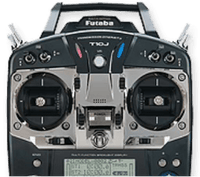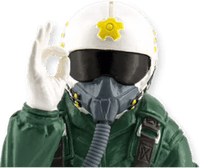What To Do When You Crash?
von Ikaika Enos(Originally published on Hobby Squawk's thread "How well do you crash?" on 11/14/2016)
Part of my job involves evaluating aircraft to and past their failure points. "Controlled Landings", "Dirt Naps", or an "Aggressive De-Kitting" are all part of the territory. The first bit of advice I give to my students brand new to the hobby is "Don't be afraid to crash --we all do it!". If they're less afraid to crash, they're less tense, more alert, more respectful of the aircraft and potential hazard, and ultimately they learn habits that promote a more SAFE and FUN experience in the wide world of RC flying.
I'm a strong believer in the adage "Fail to Plan... Plan to Fail". Beginning a flight having already visualized what you'll do in the case of an in-flight emergency is always a prudent plan, and could minimize damage should the worse occur. In the same way that I begin each flight with a flight plan, I'm also prepared mentally for certain worst case scenarios.
These scenarios depend on the aircraft, so it's important for pilots to consider what kinds of risks they're taking with their specific aircraft, be it a gasser, an EDF, a jet, a seaplane, a multi-engined aircraft, etc. Some of these risks overlap and some are unique to a given aircraft. If, for example, I'm flying a twin engine aircraft, I mentally practice what I would do if one of the motors failed. The moment an engine fizzles is not the moment you want to be thinking for the first time "What do I do now?" By then it needs to be instinctive. In the context of a twin losing an engine, throttling up the other is almost always a death sentence.
Regardless of the aircraft, here are a few actions and thoughts that ideally occur between an in-flight emergency and when the aircraft reaches the ground. The prevailing mindset should be "Fly through the crash."
1) Immediately upon detecting a failure, whether it be a dead battery, failed servo, smoked ESC, loose wing, etc, immediately call out "Emergency!", "Heads up!" or something similarly unmistakable. Notifying people around you should be your first concern.
2) Assess your aircraft's disposition. Is it definitely going to crash? If so, call it out, and do your best to avoid people or property. Is it possible to avoid a crash? If so, maintain adequate airspeed and head for the nearest flat clearing away from people or property. If your airspeed is too low and you can't make it to the runway, don't get greedy making that final turn. Just keep it flat wherever it's pointed. I've seen so many aircraft cartwheel while stalling on the final turn because the pilot didn't want to keep it flat. Swapping landing gear is cheaper than replacing an entire plane. If you can make it back to the landing, call it out and do so. Remain calm. Spotters are helpful in these situations because they can talk you through your approach and confirm the runway is clear while you concentrate on bringing the aircraft down safely.
3) If for whatever reason the aircraft doesn't make it back down on its wheels, then prepare yourself for a walk out to retrieve it. I always bring my radio with me, and toggle my Throttle Cut button so I don't bump the throttle stick while walking. Don't turn your radio off, either. If your radio is set for failsafe and the battery is still plugged in at the crash site, your motor could spin up and do even more damage there.
4) I tend to hustle out to crash sites, because you never know if the battery is damaged and may start a fire at any time. If you crashed in a pond, then disregard this step. :)
5) Upon reaching a crash site, the first thing to do is recover the battery, if it is an electrically-powered aircraft. Disconnect the battery and inspect for damage. If damaged, see our Knowledgebase blog article on proper battery disposal.
6) The rest of the steps are fairly obvious. Pick up the pieces, go home, test the electronics before deciding if you'd risk using them in another aircraft, dust yourself off, and take out the glue and get back in the game!
I will add that one of the most valuable habits to do AFTER a crash is the post-crash analysis. Use the crash as a teaching moment. Was the cause preventable? Did you reverse your ailerons, or forget to tape down that servo wire in front of the fan, or forget to CG the model properly, snap roll or lost orientation, or did you puff a battery or overamp an ESC?
Learn why and adjust your actions so it doesn't happen again. Was the cause out of your control? Failed servo, mid-air collision, etc? Reassure yourself that crashing is part of the hobby, and if this is your first one, tell yourself you've just joined an esteemed group of dirt napping professionals. We welcome you. :)
Get the latest from Motion RC sale and product announcements
You can unsubscribe at any time!

Hobby Squawk Community Forum
visit forum
RC Knowledge Blog
visit blog
Guidance & advice for beginners
Find out more- Wenn du eine Auswahl auswählst, wird eine vollständige Seite aktualisiert.
- Drücke die die Leertaste und dann die Pfeiltasten, um eine Auswahl zu treffen.
